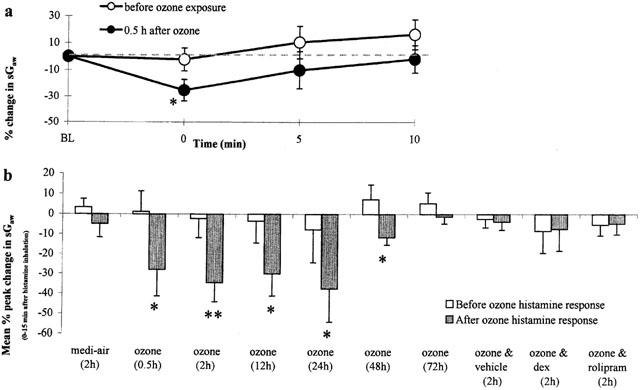Figure 3.

The airways responsiveness of a nose-only exposure (20 s) to histamine (1 mM) before and (a) 0.5 h after exposure (90 min) to ozone (2.15±0.05 p.p.m.); (b) 0.5, 2, 12, 24, 48 and 72 h after exposure (90 min) to ozone, 2 h after exposure (90 min) to medi-air, and 2 h after ozone with vehicle, dexamethasone (dex, 20 mg kg−1), or rolipram (1 mg kg−1) treatment, in conscious guinea-pigs. Treatment was administered (i.p.) 24 and 0.5 h before exposure to ozone. Each point (n=6) represents the (a) mean±s.e.mean change in sGaw expressed as a percentage of the baseline sGaw values (sGaw (sec−1 cmH2O−1) before=0.37±0.02 and after=0.40±0.02); (b) mean±s.e.mean of individual peak change in sGaw from baseline sGaw values, 0 – 10 min following inhalation of histamine expressed as a percentage of the baseline, 24 h before and: 2 h after medi-air (before=0.27±0.01 and after=0.28±0.01); 0.5 h (before=0.37±0.02 and after=0.40±0.02), 2 h (before=0.31±0.01 and after=0.33±0.02), 12 h (before=0.33±0.02 and after=0.31±0.03), 24 h (before=0.34±0.03 and after=0.35±0.02), 48 h (before=0.32±0.01 and after=0.28±0.01), 72 h (before=0.31±0.01 and after=0.30±0.01) after ozone, and 2 h after ozone and vehicle (before=0.33±0.01 and after=0.32±0.01), dex (before=0.34±0.02 and after=0.33±0.03), or rolipram (before=0.33±0.02 and after=0.27±0.02) treatment. Negative values represent bronchoconstriction. Differences between before and after exposure to histamine were determined by analysis of variance (single factor), followed by a Student's (paired) t-test and denoted as *P<0.05 and **P<0.01.
